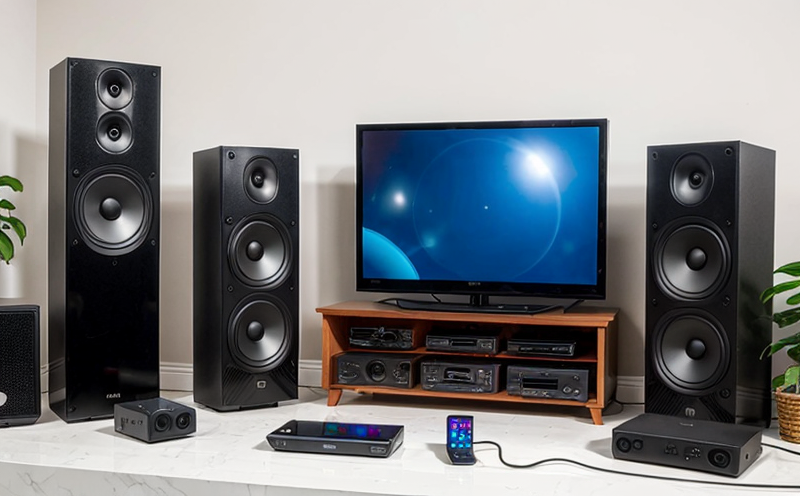EN 62087 Energy Efficiency Testing for Multimedia Systems
The European Standard EN 62087 is designed to ensure that multimedia systems, including consumer electronics and audio-visual devices, meet the stringent energy efficiency requirements set by international standards. This standard aims not only to protect the environment but also to provide consumers with products that are cost-effective in terms of electricity usage.
EN 62087 covers a wide range of multimedia systems such as televisions, soundbars, home theater systems, and other devices that incorporate audio-visual functionalities. The standard emphasizes not only the initial energy efficiency but also the long-term performance to ensure sustained compliance over the product's lifecycle.
The testing process under EN 62087 involves several key steps. It starts with the selection of representative samples from each category of multimedia systems. These samples are then subjected to a series of tests that measure their energy consumption in various operational modes, including standby, sleep, and active use. The standard also mandates the measurement of power consumption under different environmental conditions such as temperature and humidity.
One critical aspect of EN 62087 is its requirement for the testing of multimedia systems at both nominal input voltage and actual operating conditions. This ensures that the energy efficiency claims made by manufacturers are accurate and applicable to real-world scenarios. The standard also includes provisions for the measurement of power consumption in all possible modes of operation, which can vary significantly between different types of devices.
The results of these tests are then compared against the limits specified in EN 62087. If a device fails to meet these limits, it may be subjected to additional testing or modifications until it complies with the standard. The compliance officer must ensure that all necessary documentation is prepared and submitted for each test run.
Quality managers play a crucial role in ensuring that the testing process adheres to EN 62087 requirements. They oversee the selection of samples, the setup of test environments, and the analysis of results. R&D engineers are responsible for designing products that meet or exceed these standards while maintaining high levels of performance and reliability.
The compliance officer must be familiar with all aspects of EN 62087 to ensure that their organization remains compliant with regulatory requirements. This includes understanding the scope of the standard, the test procedures, and the reporting requirements. The role of a compliance officer in this context is to ensure that all products are tested thoroughly and accurately.
For procurement teams, EN 62087 represents an opportunity to source components and materials that contribute to energy efficiency without compromising performance or reliability. By selecting suppliers who adhere to these standards, organizations can ensure that their final products meet the highest quality benchmarks.
Quality and Reliability Assurance
Ensuring quality and reliability is crucial for any product that complies with EN 62087. Quality managers play a vital role in this process by overseeing the selection of samples, the setup of test environments, and the analysis of results. They must ensure that all necessary documentation is prepared and submitted for each test run.
The testing process under EN 62087 involves several key steps. It starts with the selection of representative samples from each category of multimedia systems. These samples are then subjected to a series of tests that measure their energy consumption in various operational modes, including standby, sleep, and active use.
The standard also mandates the measurement of power consumption under different environmental conditions such as temperature and humidity. This ensures that the energy efficiency claims made by manufacturers are accurate and applicable to real-world scenarios. The compliance officer must ensure that all necessary documentation is prepared and submitted for each test run.
R&D engineers are responsible for designing products that meet or exceed these standards while maintaining high levels of performance and reliability. They work closely with quality managers to ensure that the design specifications align with EN 62087 requirements.
The role of a compliance officer in this context is to ensure that all products are tested thoroughly and accurately. This includes understanding the scope of the standard, the test procedures, and the reporting requirements. The compliance officer must be familiar with all aspects of EN 62087 to ensure that their organization remains compliant with regulatory requirements.
For procurement teams, EN 62087 represents an opportunity to source components and materials that contribute to energy efficiency without compromising performance or reliability. By selecting suppliers who adhere to these standards, organizations can ensure that their final products meet the highest quality benchmarks.
International Acceptance and Recognition
- EN 62087 is recognized internationally for its stringent energy efficiency requirements.
- The standard ensures compliance with regulatory requirements in multiple countries.
- Products that comply with EN 62087 are accepted worldwide, ensuring market access.
- The standard's acceptance enhances the reputation of manufacturers who adhere to it.
EN 62087 is widely recognized and accepted internationally. Its stringent energy efficiency requirements ensure compliance with regulatory standards in multiple countries. This recognition enhances the reputation of manufacturers who comply with the standard, making their products more attractive to global markets.
Competitive Advantage and Market Impact
Compliance with EN 62087 provides a significant competitive advantage for manufacturers in the consumer electronics and audio-visual devices sector. By adhering to this standard, companies can differentiate their products from competitors by offering energy-efficient solutions that meet or exceed regulatory requirements.
The standard's focus on long-term performance ensures sustained compliance over the product's lifecycle, which is crucial for maintaining a positive reputation among consumers. This reputation translates into increased market share and customer loyalty. Furthermore, compliance with EN 62087 can help manufacturers avoid potential legal issues and fines associated with non-compliance.
In conclusion, EN 62087 energy efficiency testing for multimedia systems is essential for ensuring that products are environmentally friendly and cost-effective in terms of electricity usage. By adhering to this standard, manufacturers can gain a competitive edge, enhance their market reputation, and ensure long-term compliance with regulatory requirements.





